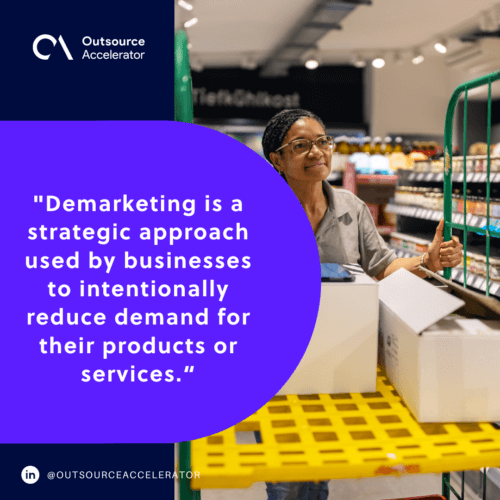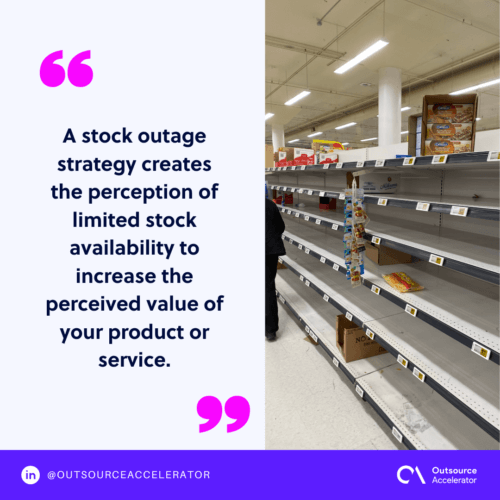Demarketing 101: Definition, types, and examples

In the world of marketing, we often hear about strategies to attract customers and increase demand for products or services.
However, there’s another side to the coin that’s equally important but less talked about — demarketing.
HubSpot indicates that marketing serves as the primary driver of revenue growth for around 91% of marketers. Yet, in this age of intense competition and aggressive marketing strategies, some may choose to implement demarketing tactics.
Let’s learn more about what this “non-marketing strategy” is. We’ll also discuss its types, provide some examples, and share some useful strategies.
What is demarketing?
Demarketing is a strategic approach used by businesses to intentionally reduce demand for their products or services. While it may sound counterintuitive at first, there are various reasons why companies might choose to implement non-marketing strategies.
One common reason is when demand exceeds an organization’s capacity to meet that demand.
Consider a popular restaurant that is consistently booked to capacity and unable to serve all the customers who wish to dine there.
To manage demand and enhance the experience for current customers, the restaurant can use demarketing methods such as raising prices or reducing operating hours.
Another scenario where “anti-marketing” can be useful is in industries or sectors that have negative externalities.
An example of this is the tobacco industry. There, anti-marketing efforts are aimed at discouraging tobacco use to reduce health risks and associated social costs.

Benefits of demarketing
As we’ve mentioned, “not marketing” may appear counterintuitive, but it actually provides these benefits:
1. Improved customer experience. Businesses can enhance the experience for their current customers by managing and avoiding overcrowding or overwhelming demand.
2. Enhanced brand image. Anti-marketing efforts aimed at promoting social responsibility and sustainability can help build a positive brand image and boost customer loyalty.
3. Strategic positioning. Applicable tactics can help businesses position themselves strategically by targeting the right customers and managing demand effectively.
4. Regulatory compliance. Demarketing can help companies comply with government regulations and industry standards by discouraging the consumption of harmful or regulated products.
Types of demarketing
There are several types of non-marketing strategies that businesses can employ:
General demarketing
This aims to reduce overall demand for a product or service by making it less accessible or attractive to potential customers.
A common example is introducing taxes or regulatory restrictions on certain products to discourage their consumption.
Selective demarketing
When you demarket selectively, it involves targeting specific customer segments or geographic areas to reduce demand for a product or service.
A good example would be a luxury hotel chain limiting its marketing efforts to high-income individuals. This indirectly demarkets to customers who are unlikely to afford their rates.

Ostensible demarketing
This form involves deliberately giving the impression that a product or service is not readily available or is in short supply. It creates the perception of scarcity, which can enhance the product’s appeal to select target markets.
A popular example is fashion brands that create limited-edition collections, thereby implying exclusivity and generating buzz around their products.
Examples of demarketing
To further illustrate the concept of not marketing your product or service, let’s consider a few examples:
1. Coco-cola
In response to health-conscious trends, Coca-Cola has quietly pivoted towards promoting its diet and zero-sugar options.
While continuing to endorse its iconic beverages, the focus on healthier alternatives serves as a strategic demarketing approach for the sugary drinks.
2. Apple
At times, Apple scales back its promotion of older iPhone models by discontinuing them and shifting marketing efforts towards newer, more advanced models.
This strategy encourages consumers to invest in the latest technology, gradually phasing out older products.
3. Lego
Since 2003, Lego has bounced back and thrived after almost becoming bankrupt. Now, it has seen a revenue increase of around 15% in the past years.
As a result, the Danish toymaker has aggressively scaled back its advertising efforts because it couldn’t keep up with demand.
Demarketing strategies to implement
If you are considering incorporating demarketing into your business strategy, here are a few methods to consider:
Price discrimination
This involves tailoring your pricing to different customer segments. You can offer discounts or special pricing to specific target markets while charging higher prices to others.
This way, you can control demand and attract your most profitable customers.
Bait and switch
This means grabbing customers’ attention with an enticing offer, only to redirect them to a higher-priced alternative. It discourages bargain hunters and helps you manage demand more effectively.
Stock outage
A stock outage strategy creates the perception of limited stock availability to increase the perceived value of your product or service.
You accomplish this by temporarily limiting inventory or announcing stock shortages periodically to stimulate demand from customers who fear missing out.

Crowding cost
During peak times, you can impose additional costs or inconveniences on customers to manage demand. Theme parks often implement surge pricing to discourage visitors who aren’t willing to pay a premium.
Differentiation
This strategy sets your product or service apart from competitors. You would highlight unique features or benefits that appeal to a specific market while potentially deterring those who may not fully value those characteristics.
Manage demand with demarketing
Demarketing offers a nuanced approach to managing demand and shaping consumer behavior in today’s dynamic marketplace.
Whether it’s advocating for sustainability, addressing public health concerns, or preserving exclusivity, this unconventional strategy serves as a valuable tool.
By leveraging it, you can navigate the complexities of the modern business environment while staying true to your values and objectives.







 Independent
Independent




